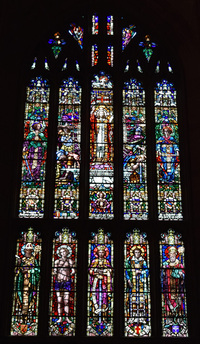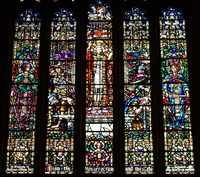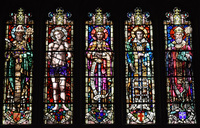Window
Building Name: Cathedral of the Most Blessed SacramentStudio Name: Willet Hauser Architectural Glass
City: Detroit
Window Shape: 6 (gothic arched, more than 2 vertical sections)
Subject/Title of Window: The Resurrection of Christ
Brief Description of Subject: The canopy topping this five panel window is decorative in nature highlighted by angels with censers.
The scene below is topped with decorative inscriptions from the Vulgate based on Matt. 28:4-5. The "Guide to the Cathedral of the Most Blessed Sacrament" gives an excellent description of this scene (see last paragraph). Just some comments. The Biblical inscription is John 11:25 and were the words Jesus spoke to Martha who did not understand what He meant when he told her that he would bring Lazarus back to life. The scriptures do not cover the actual Resurrection scene rather they begin with the empty tomb, thus artists are given a wide latitude in their portrayal of the Resurrection, however there was a time when the Catholic Church discouraged the depiction of the risen Christ hovering above the grave as in this window, feet were to be on the ground. The two angels that are depicted guarding the tomb comes from the Old Testament where two cherubim angels were assigned to guard the Ark of the Covenant. Above Christ's head is a lamb sitting on a book with 7 seals --- this is the lamb (Christ) who will open the 7 seals in the Apocalypse. Christ is holding a pole with the "victory over death" banner and a ribbon with the letters "I C X C" which is Christogram based on taking the first and last letters of the Greek words for Jesus Christ --- IHCOYC XPICTOC. On the stole that Jesus is wearing, just below the neck, are the Greek letters Alpha and Omega -- I am the beginning and the end. The Roman soldier is carrying a standard with the letters "SPQR" which stands for "Senate and People of Rome". Below the scene are decorative coats-of-arms as befitting a Norman styled church as well as an angel holding a crown of thorns.
In the lower portion of the window is found five saints with the artist's creation of their coat-of-arms.
St. Gregory of Nazianzus (c.330 - 389) a Doctor of the Church, was drawn to contemplative life and excelled at writing homilies and poems. Reluctantly, he left that life to serve as Bishop of Constantinople. Attributes seen here include costumed as a bishop with miter and crosier, quill pen, book, and in the coat-of-arms the Greek letters "IHS" --- short for the word "Jesus".
St. Sebastian (3rd Century) was a Christian who became a Roman soldier eventually becoming a member of the imperial guard. With the Diocletian persecution of Christians, he was sentenced to die by being tied to a tree and shot with arrows. Somehow he survived the injuries from the arrows and was nursed back to health. Rather than fleeing he confronted the emperor with his faith and was killed by flogging. It is surmised that he is most often shown semi-nude to show off the arrow wounds and give artist's the license to depict a young, partly clad, male body. Attributes seen here include semi-clad and shot with arrows. I was not able to relate the coat-of-arms to St. Sebastian.
St. Louis IX (1214 - 1279) was a devout Christian and administered to the poor. He led the 6th and the 7th Crusade -- dying of disease at the start of the 7th. Attributes seen here include dressed in royal garb and crowned, a sword (Crusades), scroll with words from 2Corinthians 5:14 "Caritas Enim Christi Urget Nos" -- the love of Christ completes us (devout Christian), and in the coat-of-arms a pomegranate which symbolizes the Resurrection (hope for eternal life).
St. Lawrence (3rd Century) was a deacon who helped the poor. He was called to Rome and appointed as archdeacon by Sixtus II. When Sixtus was martyred, Lawrence became in charge of the Church's treasury. When the Roman official demanded he turn over the treasury to him, Lawrence gave all the wealth to the poor. This angered the official who then had him put to death. Legend has it that he was placed on a grate and grilled to death. Attributes seen here include dressed as a deacon (in a dalmatic), a grate, palm frond (martyrdom -- triumph over death), and a cross in his coat-of-arms.
St. Patrick (390 - 461) was a missionary who evangelized in Ireland converting much of its populace to Christianity and establishing monasteries. He became the Bishop of Ireland and is most remembered today for eliminating the snakes from Ireland and using the image of a shamrock to teach the mystery of the Holy Trinity. Attributes seen here include dressed as a bishop with miter and pastoral staff, shamrocks, stepping on a snake and stabbing it with his staff, a book (preached the word of God), and a cross in the coat-of-arms.
From the Guide to the Cathedral of the Most Blessed Sacrament, Copyright 1958, Archdiocese of Detroit.
Here Christ stands in shining glory. Angels with swords stand on the extreme right and left and on the two inner panels the Roman guards cower in fear, overcome by the dazzling glory of the Risen Saviour. Beneath the main panels are St. Gregory Nazianzen, St. Sebastian, St. Louis, St. Lawrence, and St. Patrick.
Inscriptions: In Memory of Anthony and Mary Grix
I am the Resurrection and the Life He that Believeth in Me altho be Dead shall Live
Height: 25'
Width: 12'
The Resurrection of Christ
The Resurrection of Christ, scene
The Resurrection of Christ Saints
The MSGC is a constantly evolving database. Not all the data that has been collected by volunteers has been sorted and entered. Not every building has been completely documented.
All images in the Index are either born-digital photographs of windows or buildings or are scans of slides, prints, or other published sources. These images have been provided by volunteers and the quality of the material varies widely.
If you have any questions, additions or corrections, or think you can provide better images and are willing to share them, please contact donald20@msu.edu





